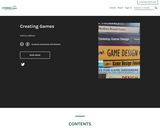
Online textbook to accompany CMDI 1105 Creating Games.
- Subject:
- Business and Communication
- Communication
- Material Type:
- Textbook
- Provider:
- Plymouth State University
- Author:
- Cathie LeBlanc
- Date Added:
- 02/18/2020

Online textbook to accompany CMDI 1105 Creating Games.
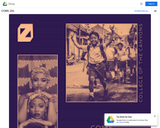
Examines intercultural communication, including cultural patterns, verbal and nonverbal communication codes and their practical application in today's diverse society.
Chapter 1 - Foundations of Culture
Chapter 2 - Understanding Cultural Identity
Chapter 3 - Social Construction of Cultural Identity
Chapter 4 - Cultural Biases
Chapter 5 - Taxonomies of Cultural Patterns
Chapter 6 - Understanding Intercultural Communication
Chapter 7 - Intercultural Communication Competence
Chapter 8 - Striving for Engaged and Effective Intercultural Communication

This course introduces managers and other professionals working in the nonprofit sector to Value Based Management. The course attempts to establish a common framework for how nonprofit's and non-governmental organizations can apply Value Based Management in such areas as Strategic Planning, Resource Development, Leadership, and Performance Measurement. Course Level: Intermediate - A good understanding of business concepts is useful for fully understanding this course. A review of other Short Courses is also recommended since this course covers topics that may be covered in greater deal in another short course. Recommended for 2.0 hours of CPE. Course Method: Inter-active self study with audio clips, self-grading exam, and certificate of completion.

I answer a question for Ashlee in Virginia. This video shows users how to create a hypertext PowerPoint presentation. A Hypertext PowerPoint presentation is a great tool to use for students to allow them to progress at their own pace.
This is part of our PowerPoint tutorials. I use PowerPoint 2013.

On Episode 2 of the Sustainable Funding Vlogcast for Media, Educators, Technologists, and Creators, author of Animals of the Great War - Maria Grazia Suriano talks about creating a social economy with crowdfunding and OER (Open Educational Resources) with vlogcast host Erica Hargreave. Over the course of their conversation, Maria and Erica explore everything from the concept behind Animals of the Great War, teaching about othering, instilling empathy, what school kids responded to about the book, the importance of open access in education, crowdfunding in Italy, lessons learned from running a crowdfunding campaign, and various avenues to explore in creating a social economy. Scroll down for a time coded breakdown of key chatting points from this interview.
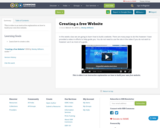
This is video is an instructive explanation on how to build your own free website.

This lesson allows students to work on their keyboarding skills while creating pieces of music. Students can choose classiccal music, current hits, or just play around with the keyboard. Students will then be able to create an app using Code.org's AppLab that uses a recording of the music they play.
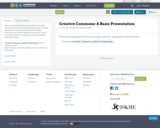
This is a short PowerPoint (with sound!) on Creative Commons. This is a brief introduction on what Creative Commons is, the basic terms used for Creative Commons, and how the licenses can be used to share work with a variety of restrictions, from very open to somewhat closed.

Making Ethnic Identity through Objects
Short Description:
This catalogue was built to accompany "Creators, Collectors and Communities: Making Ethnic Identity through Objects," the inaugural exhibit of Mount Horeb's Driftless Historium.
Long Description:
This catalogue was built to accompany “Creators, Collectors and Communities: Making Ethnic Identity through Objects,” the inaugural exhibit of Mount Horeb’s Driftless Historium. The exhibit opened in June 2017.
Word Count: 12972
(Note: This resource's metadata has been created automatically as part of a bulk import process by reformatting and/or combining the information that the author initially provided. As a result, there may be errors in formatting.)

Students will be able to:
-Correctly use fundamental vocabulary related to credit and lending
-Explain how loan amortization and payments work
-Understand how principal, interest rate, and term are critical components to evaluating credit options
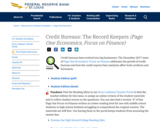
Credit bureaus have evolved into big businesses. The December 2017 issue of Page One Economics: Focus on Finance addresses the growth of credit bureaus and how the credit reports they maintain affect both creditors and borrowers.

With record-level credit card debt in the headlines, this December 2023 issue of Focus on Finance addresses credit card history, statistics, and usage, as well as reasons for the increase in credit card debt. The information in the article can help in managing credit card accounts, and students will better understand the economics of using revolving credit as they prepare to become cardholders!
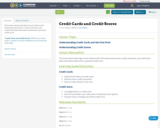
This lesson will provide high school students with information about how a credit card works, and understand what information determines a personal credit score.
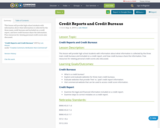
This lesson will provide high school students with information about what information is collected by the three main credit bureaus and included on a credit report, and how credit bureaus share the information. Free resources for viewing personal credit scores also discussed.
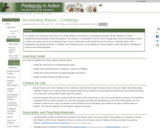
Accounting is the language of business. As a result students must grasp the vocabulary associated with the discipline to have a fundamental understanding of financial reporting. This activity is a combination of the five-card Cribbage game and the board game Bingo. It makes use of game theory as an alternate way to cover content that would typically be part of a lecture. Cribbingo fosters class participation by making learning fun. In addition, the Cribbingo lecture can be adapted to classes taught in many disciplines, including the sciences and world languages.
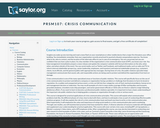
Crisis communication is one of the many specialized areas or functions of public relations. This course will specifically focus on the use of crisis communication to protect and defend a company or organization facing a problem or challenge that threatens to harm its brand or reputation. As a sudden and unexpected serious event, a crisis can fall into four categories: acts of God, mechanical problems, human error, and management decision or indecision. You may recall examples of crisis in news media coverage of killer earthquakes and tsunamis, grounded airplanes, stranded cruise ship passengers, and senior government officials or CEOs who are fired or asked to resign following adulterous affairs. If you want to learn to become a professional public relations specialist, it is important to have a basic understanding of the important role public relations has in helping guide a company or organization through a crisis or serious event.
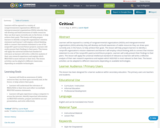
Learners will be exposed to a variety of nongovernmental organizations (NGOs) and intergovernmental organizations (IGOs) whereby they will develop and build awareness of viable resources they can draw upon currently and, in the future, to help achieve their goals. This lesson will help prepare learners to identify a nonprofit organization’s mission statement and learner’s will employ critical thinking skills to connect that mission statement to one of the nonprofit’s past/current/future projects. Learners will orally present their findings to their peers. This lesson will apply the universal intellectual standard of relevance as learners will write a reflective analysis of their own research experience and explain which NGO/IGO is most relevant to their lives. The lesson activities can be adapted to different classrooms depending on available technologies.
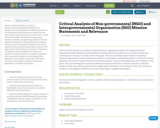
Learners will be exposed to a variety of nongovernmental organizations (NGOs) and intergovernmental organizations (IGOs) whereby they will develop and build awareness of viable resources they can draw upon currently and, in the future, to help achieve their goals. This lesson will help prepare learners to identify a nonprofit organization’s mission statement and learner’s will employ critical thinking skills to connect that mission statement to one of the nonprofit’s past/current/future projects. Learners will orally present their findings to their peers. This lesson will apply the universal intellectual standard of relevance as learners will write a reflective analysis of their own research experience and explain which NGO/IGO is most relevant to their lives. The lesson activities can be adapted to different classrooms depending on available technologies.

This is a short description of the differences in business between cost and price, as well as consumer and business customer. These terms are often confused.
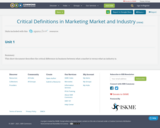
This short document describes the critical difference in business between what a market is versus what an industry is.